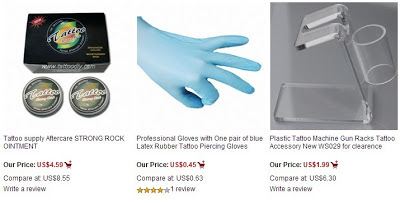Lighting: The area must be well-lit. Counter and floor space should be lightly colored so dirt shows up easier. The spray bottle the artist uses on your skin should be disinfected between customers, or some kind of protective film such as Saran Wrap should be used.
Disposing needles: All tattoo needles must be either discarded after EACH use (or at least with each new customer), or autoclaved. Many body piercers operate out of small booths and may not have spent money for an autoclave, in which they must dispose of each needle. no exceptions.
Needles touching other things: The needles, once open from their sanitary packages, must not be placed on unsanitized surfaces. The piercer should not set the needle down on the table or have the needle touch the ground. If this happens and they don't get a new needle, insist they do.
Tattoo Gloves : The artist must wash their hands prior to putting on their gloves, preferably with an antibacterial/antiseptic solution. Once they put their gloves on, they should not touch anything other than your skin, the needle, and the jewelry. They should not be filling out receipts beforehand, or answering the phone unless these have been wiped clean beforehand.
Is there a sink separate from the bathroom sink? Does the artist use a disposable razor when shaving skin?
The Speed Stick used as an adhesive for the tattoo pattern should not be directly applied to the skin, but applied first to a tissue which can then be used on the skin. Autoclaves should be inspected regularly. Sterile materials should be stored in sealed containers away from things that could cause body fluids or ink to splash on them. The palate that holds the ink caps should be covered. After tattooing, the ink caps should be discarded, and the ink not reused poured back into the bottles.
Be particularly wary of outdoor fair booths. While many are run by caring, experienced artists, these booths allow fly-by-night operators to make some fast money and disappear. If you don't know the artist, spend time watching them work on others first. Are they reusing needles? Do they use needles that have dropped on the ground?
If you see any unsanitary conditions that are particularly alarming, post them to RAB. If you feel uncomfortable naming names, then withhold the specifics for private email. It is each customer's right to guard against getting a contamination. Worse, If you have had more than one tattoo or piercing within several months, it will be difficult for you to prove which artist was responsible!


No comments:
Post a Comment